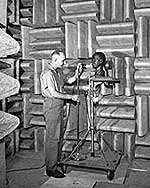1925: Shure Radio Company is founded on April 25 by Sidney N. Shure as a one-man company selling radio parts kits before factory-built radio sets were marketed. Office is located at 19 South Wells Street in downtown Chicago.
1926: A direct mail catalog is published, one of only six radio parts catalogs in the U.S.
1928: Shure grows to more than 75 employees. Sidney N. Shure’s brother, Samuel J. Shure, joins the company. Shure Radio Company becomes Shure Brothers Company, moving to more spacious quarters at 335 West Madison Street, Chicago.
1929: The Great Depression grips the world. Market for radio parts kits declines when factory-built radio sets become available. Staff is reduced to a few people. Shure becomes exclusive distributor for a small microphone manufacturer.

1930: Samuel J. Shure leaves to pursue a career in heating and ventilation engineering, his college major, joining a prominent company in St. Louis, Missouri.
1931: Shure begins development of its own microphones under the direction of a young engineer named Ralph Glover.
1932: Shure becomes one of only four U. S. microphone manufacturers with the introduction of the Model 33N two-button carbon microphone. It is the first lightweight, high-performance product in a market dominated by large, costly devices.
1933: Model 40D is the company’s first condenser microphone.
1935: Model 70 is Shure’s first crystal microphone.
1936: First patent is received for a stylish and practical suspension support system for microphones.

1939: Model 55 Unidyne microphone is the first single-element unidirectional microphone. Its performance qualities and distinctive styling ultimately make it “the most recognized microphone in the world.” Notably, the single-element design makes microphones smaller, less expensive, and, therefore, more accessible to all.
1941: Shure secures contracts to supply microphones for U.S. armed forces in World War II.
1942: T-17B Microphone becomes the most widely used microphone by the U.S. Army and Navy. Shure develops plastic cases for these mics, preventing them from getting too hot to handle in tanks and, also, conserving scarce metal for the war effort.















